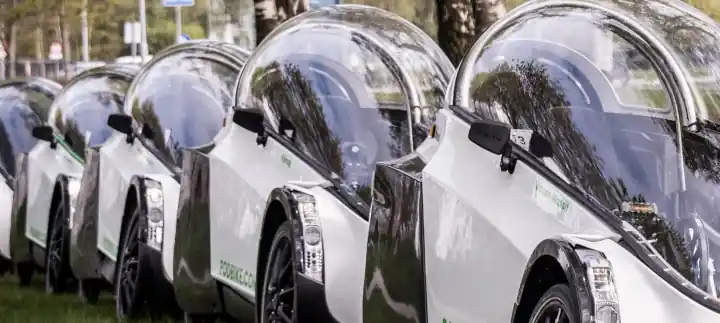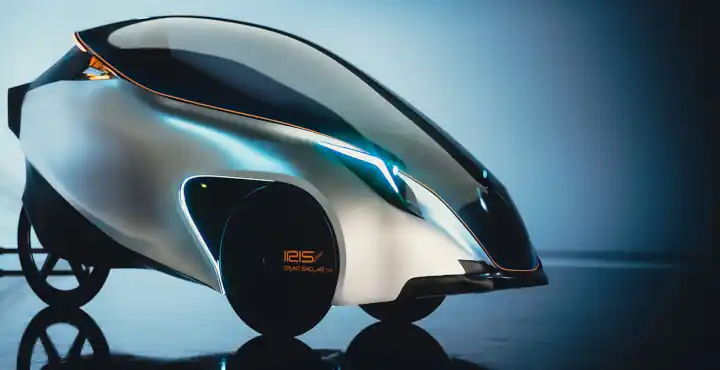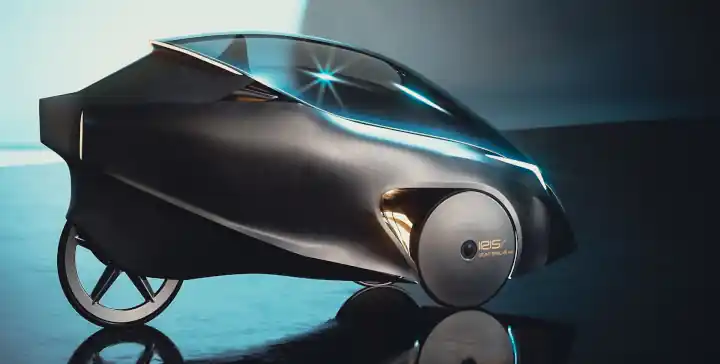Velomobiles – Electric Assisted All Weather Bikes

WHAT ARE VELOMOBILES
Velomobiles are fully enclosed, weatherproof bicycles, tricycles or bicycle-like four wheel vehicles. Most velomobiles are built onto the chassis of recumbent electric trikes. Recumbent trikes and e-trikes are usually regarded as ebikes (assuming power compliance). Pedelec compliant four wheel velomobiles are also gaining compliance as bicycles in most countries.
A myriad of velomobiles are attracting greater interest with each passing day. Although many velomobiles are advertised for sale, few models are readily available for purchase. I detail the front runners in the velomobile arena and their availability. In addition, I analyze the market potential and discuss why there is a hesitation to mass production.
THE NEED FOR VELOMOBILES
Anyone who has visited a European city in recent years will understand the need for e-bikes, e-scooters and velomobiles. Moreover, in Europe, e-bikes are now a mainstream form of city and urban transport.
A number of issues are expanding the need for e-bikes that can be used in all weather conditions. Enter the velomobile!

Zero Emission Zones (ZIZ), Ultra Low Emission Zones (ULEZ), and Low Emission Zones (LEZ)
The major cities of Frankfurt, Berlin (Germany), Modena (Italy), Madrid (Spain), even London and Manchester (England) are enforcing low, or zero, emissions zones. Many other cities have completely banned fossil fuelled engines, while others impose large taxes (or enforce fines) for driving non compliant vehicles.
Large cities are not alone in the drive for Zero Emission Zones, almost all Dutch towns, and many other ‘clean air’ advocates, like Zermatt, Switzerland, have jumped on the sustainability bandwagon. 100 EU cities have committed to be carbon neutral before 2030.
The drive for carbon neutrality essentially means that all fossil fuel cars will be banned from the majority of European towns and cities over the next seven years.

Decades of Expansion in Personal Transport
The ban (or additional taxes) on petrol and diesel power in cities is not the only thing “ fuelling” the need for e-bikes (pardon the pun). Finding a vacant car parking bay in any parking lot is near impossible in most European centers and even urban areas.
Fear of losing a much coveted parking spot means that cars remain parked for an increasing portion of their life.
Adding to this, my experience of driving a full size car down narrow lanes can be near impossible. Driving a large car in Europe is stressful. Having only millimetres to spare on either side of the car, tight bends and parking bays designed for compact vehicles, increases the likelihood of collision. Try opening a car door with only 3” between the cars parked on either side and you can appreciate the nightmare.
Electric bikes and scooters are now THE transport of choice for densely packed European towns and the need for more flexible electric vehicles is strikingly obvious. All weather velomobiles provide an immediate solution to help current, and future, commuter transport.

THE DEMAND FOR ALL WEATHER E-BIKES
All weather electric bikes are not a new concept. The European epoch of impossible parking and Zero Emission Zones has, however, stimulated a massively increased demand.
THE FIRST MASS PRODUCED VELOMOBILE
The early 1980’s saw bicycle manufacturers successfully lobby for a ban on the first production EV (The Sinclair C1). Following a revised concept, the Sinclair C5 tricycle was released in 1985 only to berated by massive media criticism.
In the 1980’s, the C5 was castigated for being:
- Slow. At 15 MPH (24KPH) the recumbent e-trike was slated for being too slow,
- Limited range. 20 Miles (32 Kilometres) was not sufficient,
- Too low. It was suggested that the C5 posed a danger to traffic.
- Expensive. The recumbent e-trike was regarded as too costly at £399 (US$483, €463).
These C5’s limitations that were slated are accepted norms for today’s eBikes. The EV of the 1980’s was competing in a petrol dominated world of plentiful parking, and the relatively quiet roads of the day.
The adverse criticism caused the demise of the C5. Production ceased after fabricating only 14,000 units.
The aftermarket canopy which would have made this a fully enclosed velomobile never appeared. The planned introduction of fully enclosed velomobiles (the C10, and C15) never reached production.
Moving on 40 years and the limitations of the C5 have become accepted as normal. In addition, bicycle manufacturers are now mass-producing electric vehicles that they once sought to ban.
VELOMOBILES – THE NEXT GENERATION, ALL WEATHER EBIKES
Despite the failures of the 1980’s, manufacturers are realizing that opportunity exists in the modern age. Several manufacturers have developed prototype velomobiles and yet others are in small scale production.
Manufacturers can quickly move to mass production when market opportunity is clear.
Mainstream German ebike manufacturer Canyon has developed a prototype velomobile while ELF and other low volume velomobile manufacturers.have been selling velomobiles since 2016.
The next generation of more sophisticated and lower price velomobiles are now set to enter the arena. Northern Light Motors, Grant Sinclair, Podbike, and many others are close to full scale production.
THE FIRST MASS PRODUCTION ALL WEATHER EBIKES
My first choice for both style and price are three retro style e-Trikes from Northern Light Motors. The 428, 557 and 630 models are all very similar in style but increase in features within the range.
These stylish all weather electric bikes are, in my view, the most headturning style. In addition, they are exceptionally well priced being one of the lowest cost velomobiles.
NORTHERN LIGHT MOTORS
The Northern Light 557 has a polarizing design which many love and others hate. Although a little low, this is my e-bike of choice.
Styled in the fashion of a 1920’s vintage racing car, the stunning 557 velomobile is a real eye catcher that is ramping up the competition on several fronts. It has head turning styling, it has fully featured, high tech inclusions, and it is extremely competitively priced.
- The 557 model offers a selection of vinyl wrap colors.
- It is the lowest cost electric velomobile.
- It is stylish and professionally finished.
- It has a range of up to 100 miles.
- Leaf spring suspension provides a comfortable ride.
- Storage.
- Powerful headlight, tail light and blinkers.
- Leaf spring suspension.
- Hydraulic disc brakes.
- High tech, touchscreen Heads Up Display (HUD).
- A choice of power options from 250 Watt to 3 Kilowatts.
DESIGN
The high tech lineup of velomobiles from Northern Light Motors have been designed by some of the best automotive designers in the business. The principle designer. Graham Browne, was the chief designer at TVR sports cars. (TVR were British designed sports cars nicknamed “Ferrari eaters”.)
The design incorporates crumple zones, turning lights, front and rear lights, high tech steering wheel, Heads Up Display, and leaf spring suspension.
Hydraulic brakes are included on all models with more powerful brakes on the higher powered, faster, 630 models (also available as an upgrade on lower power velomobiles).
The base model weighs 92Lbs (42Kg) with electric powered models weighing 121Lbs (55Kg) when motor and battery are added.
With minimal ground clearance, the design is not intended for off road tracks. Low to the ground styling means that these chariots reach 39” tall (1 meter) at their highest point.
Low designs have been criticized in the past, however, Northern Light Motors chose a low profile to maximize the aerodynamic efficiency and increase stability of the vehicles.
COST
The Northern Light velomobiles start at £4,000 for the pedal powered 428. Apart from the electric motor and battery, this entry level model offers the main features, and style of the more expensive models in the range. The 427 comes prepared for you to install your preferred battery and electric motor.
Electric powered velomobiles start at £5,000 (US$6,350) for the 557 model. This model includes a battery and electric motor.
Northern Light Motors are accepting orders now for delivery later this year.
You can see more or place an order through the Northern Lights website.
The IRIS eTRIKE

The IRIS eTRIKE has captured the essence of consumer demand for the velomobile. This recumbent trike is one of the most well-rounded, best designed and best priced velomobiles to date.
Grant Sinclair has taken on the original concept first pioneered by his uncle, Clive Sinclair (the Microelectronics entrepreneur behind the C5). Learning from lessons of the past, the electric tricycle concept has been revived in the form of the IRIS eTRIKE.
PRICE AND AVAILABILITY
The concept IRIS eTRIKE first made an appearance way back in 2017 however, the IRIS eTRIKE eventually went into full scale production in 2023. Presently, the e-Trike retails on-line for £5,800 with £250 estimated delivery to the US. (Total £6,050. Approx US $7,680).
DESIGN of the IRIS eTRIKE
The concept vehicle is impressive with a futuristic space capsule appearance. This velomobile has two wheels up front for improved stability, with one wheel at the rear.
Reminiscent of modern fighter jets, the full cover perspex canopy opens from the front to allow the pilot to easily access the machine. The outer skin design was inspired by aerodynamically efficient velodrome helmets and the contours, shaping ,and finish, are stylish.
The IRIS eTRIKE has addressed the original criticisms of the C5. The prototype trike accelerates quickly up to 30 MPH. The bike can be fitted with a 250, 500, 750, or 1,000 Watt motor. The 250 Watt, motor is compliant with European legislation.
The larger motors can assist the rider to reach speeds of 30MPH (48KPH) where legislation allows.
The bike now uses Li-ION batteries that were not available in the 80’s. The lighter batteries can extend the range up to 55 miles (88 Kilometres) .
The 4 foot high IRIS eTRIKE has been raised from the original C5 . The IRIS is 128cm compared to the original (under 3 foot tall) 80cm Sinclair C5.
A small external hatch behind the rider provides access to a useful storage compartment from outside the trike. The space is ideal for carrying groceries.
EFFICIENCY
The efficiency of the vehicle is paramount. Every effort has been made to reduce drag. The outer shell has been fabricated to cover all three wheels. The headlights, tail light, and turning lights are encased within the streamlined bodywork to retain aerodynamic efficiency.
HIGH TECH
Not only does the exterior of the IRIS eTRIKE look futuristic, the interior has some high tech sweeteners.
The interior is fabricated from molded plastic to match the clean, space age exterior.
A universal smartphone dock allows you to recharge your smartphone while allowing the pilot to track progress via GPS, or play music. A rear view camera connects into a smartphone. This clearly informs the driver of what’s happening behind while retaining the minimal drag coefficient. The etrike uses puncture proof Tannis tires.
The manufacturer, Grant Sinclair Futurist Ltd, has been involved in AI focused hardware for autonomous vehicles. The future of the IRIS, therefore presents an intriguing avenue for development.

SAFETY
Grant explained that a super-lightweight, high strength, foam material has been selected for the outer shell. At 55Kg (121 Lbs) the weight of the tricycle is heavier than it could have been. The trike could have shed a further 10 Kg (22 Lbs) by opting for a thinner outer casing material. The heavier casing was selected to increase rigidity, safety, and stability.
To order the IRIS eTRIKE visit the website:
www.grantsinclair.com.
PODBIKE FRIKAR
This four wheel, recumbent Frikar is second on our list of beautifully designed velomobiles. There are future plans to manufacture a 3 wheel version for the US market. (Currently 4 wheel vehicles are classed as Quads in most states)
While many, more cautious companies have design concepts on hold, Podbike is staging up production. Frikar have been repeatedly plagued by delays in production and 2024 seems to be much the same. Deposits have been accepted for 3,500 velomobiles which are now being assembled for delivery this year.
Podbike have opened their website for the next batch of orders in 2024.
DESIGN
The Norwegian company developed this velomobile from a University Master thesis first presented in 2015. Designed for the Nordic climate, the Frikar velomobile insulates the rider and passenger from harsh weather. Filtered air is pumped into the cabin by electric fan, and a heater and seatbelt are available options.
This 2 seater recumbent (1 adult and child up to 22 Kg) has an aesthetically pleasing aerodynamic shell, with a 250 Watt pedal assisted motor to target the burgeoning European market.
The batteries are designed to give a travel range between 50 and 80 Kilometers. Lights and turning lights are integrated into the design.
Podbike emphasize the importance of safety with:
- An impact crush zone designed into the frame,
- Impact absorbing material used in the shell, and
- Added roll over protection for rider and passenger.
The Frikar is 47” (119cm) tall. Ride height can be raised to 59” (150cm) if required.
The velomobile weighs a little under 200 Lbs (90Kg).
The unit even comes with a windscreen wiper and washer option and the vehicle has been designed to accept an autonomous control system at some point in the future . It seems that Podbike has thought of everything.
RIDE COMFORT
Ride comfort is often ignored by most velomobile manufacturers which confines most vehicles to smooth, sealed roads.
Although the Frikar isn’t the smoothest on rough roads, it has suspension on all four wheels which helps to take the edge off harsh bumps. Podbike offers an off road conversion kit with knobbly tires. Logical when you consider that snow and dirt roads are an integral part of life in Norway.

PRICE
The price is a little eye watering. At time of publishing the base model Frikar can be purchased for US$10,355 (€9,500) excluding taxes and delivery. A pre-order deposit of €300 secures the order, with the remainder to be paid prior to delivery. Podbike mentions that prices may rise as the world is in a high inflation period.
To pre-order the Podbike Frikar visit their website at https://www.podbike.com/
THE ELF FROM ORGANIC TRANSIT

Closer to home, US company Organic Transit has been manufacturing velomobiles since 2016. The ELF is built in Carolina and has been leading the way in production numbers for many years. The ELF has undergone a few modifications over time to address many of the earlier weak spots in design.
With no side doors, the ELF velomobiles are not fully enclosed. When compared to modern European designs, the styling is basic and the price tag is a little high. Current models have a half door which can be purchased as an accessory.
It is worth bearing in mind that transport costs and import duties are likely to elevate the price of European models when they reach the US. The ELF may turn out to be price competitive with its more stylish European counterparts.
The rear cargo window is fabricated from flexible perspex which does not convey quality, and the off road ride is uncomfortable.
ADVANTAGES
The big advantage of the ELF is that it has been in production for some time and it is available for immediate purchase (no delay waiting for production).
The unit has been field tested for many years which has allowed Organic Transit to address teething issues. Over 1,000 units have been delivered since 2016.
The roof incorporates a 100 Watt solar panel which should be able to recharge the battery if left in sunlight for a few days. (The company suggests an optimistic 8 hours to recharge from the Sun).
These velomobiles have alloy tubular frames to minimize weight although they still weigh 180Lbs (81Kg). This weight is comparable with the Frikar and other velomotors, although substantially heavier than the IRIS eTRIKE and velomobiles from Northern Light Motors.
A relatively large 48 Volt, 16Ah battery will deliver 20 to 45 miles of travel from the relatively powerful 750 Watt power plant. It is rumored that Organic Transit are considering a 1,500 Watt option although this would no longer be classed as a bicycle.
PRICE
Three models of the ELF are available, the ELF solo, The 2FR and the Practical. Retail prices start at US$8,895 to US$9,795.
OTHER CONTENDERS
The velomobile industry is impassioned with many new vehicles contending for space in this emerging industry.
Although I have covered major challenger’s at this time, it is impossible to address all the available vehicles in one article. As there is huge interest, I have provided links below to a number of models that have not been covered above.
SARL CYCLES JV-FENIOUX
Sarl Cycles is the most versatile company in the industry offering a huge variety of bikes, trikes, velomobiles and even tandem bikes. The company offers an incredible 29 velomobiles. (Note that most have a 12 months delay before delivery.)
I would highlight the two most interesting models:
- The very distinctive Mulsane, and
- The light, aerodynamic, reasonably priced Leiba Classic.€5,699 (US$ 6,270).
SUNOX
This Indian based company tackles a farm orientated sector. Their vehicles are light, with a simple construction.. This manufacturer offers flexible, work oriented vehicles, designed as short distance, clean air, farm orientated workhorses.
CITYQ
The CityQ is a Norwegian concept. The hybrid car-ebike concept is interesting as the Norwegian government may back the production for environmental reasons. The design is simple and expected to sell for around €7,500 + Tax and shipping.
CANYON FUTURE MOBILITY CONCEPT

Finally, we wanted to highlight the Canyon concept velomobile. Canyon is well established as a leading brand in the eBike world, and are well positioned to rapidly launch their future mobility concept when they feel the market is ready.
The Canyon recumbent, is a four wheel, total weather protected vehicle. The “Future Mobility Concept” seeks to bridge the gap between automobile and ebike.
Canyon proposes a 250 Watt Pedelec power plant with a 2000wH battery which would provide a range of 150 Klm.
The high quality concept has a slide forward canopy to allow the pilot easy access to the cockpit. The canopy can be left in the forward position to provide air flow in hot climates, or simply to provide an open top feel.
There is space behind the driver to accommodate a passenger or groceries.

CONCLUSION
The market for all weather eBikes is accelerating.
With Zero Emission Zones being enforced in towns, lack of parking spaces, narrow roads, and traffic congestion, the need for small electric vehicles in Europe is obvious.
Many manufacturers are entering the velomobile space and are poised for mass production. Contenders are pushing to grasp the market lead in this space.
The design, and price leaders would seem to be Northern Light Motors 557, and Grant Sinclair Futurist’s IRIS eTRIKE.
Three manufacturers entered mass production in 2023 with many others preparing prototypes awaiting confirmation of the market opportunity.
It is an interesting time in the velomobile industry and there will be a mass of new entries to this market very soon. We are about to witness these revolutionary vehicles become mainstream personal transport options.
One thin’s for sure. The race to be the leading velomobile manufacturer is on!
